 |
|
 12-22-2023, 12:54 PM
12-22-2023, 12:54 PM
|
#1
|
|
Winnebago Camper
Join Date: Dec 2023
Posts: 9
|
Batteries stopped charging under shore power
I store my 2013 Itasca Sunstar 27N hooked up to shore power and the converter keeps both the chassis and house batteries charged up, usually 13-14 volts. Two weeks ago I noticed the chassis had gone down to 12.0 and the house batteries were 12.7. I had shore power inside the RV, the microwave had power and so did the plug outlets. All batteries are two years old and the water levels are good.
I followed the Progressive Dynamics troubleshooting steps for their converter and it showed that it was sending over 14 volts to the batteries. The next step was to check the inline fuse/breakers. I found the fuse holder for the house batteries and it tested over 14 volts with the batteries (two 6v's) disconnected, but 12.7 connected. The chassis battery cable showed zero volts disconnected from the battery.
I could not find a fuse holder for the chassis battery. I tried to find it in the Winnebago wiring diagrams but couldn't for my year (2013). Oddly enough, the 2014 has a chassis battery fuse holder in the battery compartment similar to the house batteries.
So I need help to find this fuse holder, or other kind of fuse, or maybe a breaker?
Any help would be really appreciated. TIA.
Bob
|

|

|
 12-22-2023, 01:12 PM
12-22-2023, 01:12 PM
|
#2
|
|
Site Team
Join Date: Mar 2019
Location: South Bend, WA
Posts: 2,766
|
Hi Bob,
This older Thread might be helpful:
Battery resettable fuse link
Welcome to the forum.
Eagle5
__________________
2019 Minnie Winnie 22M on an E-450 frame
|

|

|
 12-22-2023, 01:37 PM
12-22-2023, 01:37 PM
|
#3
|
|
Winnebago Camper
Join Date: Dec 2023
Posts: 9
|
Quote:
Originally Posted by Eagle5

|
Once I noticed the batteries weren't charging, I used the disconnect on the chassis battery to stop it from draining. I forgot to mention in my note that the alternator provides over 14 volts at the battery. After I ran the engine I forgot to hit the disconnect again, and the next day, or two, I noticed a drop. So, the disconnect switch doesn't appear to be a reset. But thanks for the link, it was still an interesting read.
Bob
|

|

|
 12-22-2023, 02:38 PM
12-22-2023, 02:38 PM
|
#4
|
|
Site Team
Join Date: Mar 2019
Location: South Bend, WA
Posts: 2,766
|
Hi Bob,
Maybe work the problem from the other-way around? Try disconnecting from Shore Power, and see where the 12 VDC from the house batteries stops.
Thanks, Eagle5
__________________
2019 Minnie Winnie 22M on an E-450 frame
|

|

|
 12-22-2023, 04:01 PM
12-22-2023, 04:01 PM
|
#5
|
|
Winnebago Master
Join Date: Nov 2018
Location: Pflugerville/Austin, Tx
Posts: 8,613
|
I'm not clear on some small points which may be critical. Maybe some questions will help?
The drawings seem to indicate two different setups on that year and model.
Do you know if you have the older mode solenoid or newer solid state battery isolation monitor (BIM)?
I may be missing things so catch me up to speed if I'm missing something. Do you know how the chassis battery was being charged when connected to shore power?
Do you have some form of Trick-L- charger, etc. in place or other form of getting charge to the chassis when engine is not running?
I'm likely to be missing something as the group after 2010 is not as well supported as before 2010. Clue me in if I'm missing the path?
As a shotgun thought, are you aware of the battery connections just in front of the batteries on the passenger side of the frame? Maybe a good place to find an open that we could miss easily?
Also keep in mind the ground side has to be good. Easy one to forget!
Click this snip for better view.
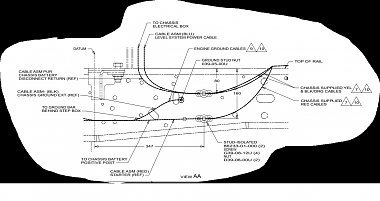
Also there is a code using tape at the ends of battery cables to help ID them. Question may be if they are still there as the RV ages?
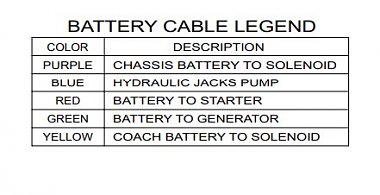
__________________
Richard
Why no RV year, make and floorplan on MY signature as we suggest for others?
I currently DO NOT have one! 
|

|

|
 12-22-2023, 08:53 PM
12-22-2023, 08:53 PM
|
#6
|
|
Winnebago Master
Join Date: May 2015
Location: Manhattan, Kansas USA
Posts: 1,389
|
You need to have the Coach Battery Disconnect Switch located by the entry door in the ON mode for the converter charger to be able to deliver charge to the Coach batteries. The battery isolation manager should close to charge the Chassis battery as needed. The Chassis Battery Disconnect Switch can be in either position for this chassis battery charging function to work.
The 2013 converter charger is a 3 stage model that should drop into trickle charge mode and not damage your batteries if left powered for long term. That said, it's important to confirm that when you check your RV batteries for good water level and confirm that the chassis DC voltage is at trickle charge level of about 13.3 volts or less every few weeks.
Method of operation:
On a 27N the converter-charger DC output connects to the coach fuse/breaker panel under the bed. When converter-charger is AC powered its output flows thru the 55 Amp Coach circuit breaker in the Chassis Electrical Box to the Coach Side of the Coach Battery Disconnect Contactor. The other side of that contactor goes to the Coach-Chassis Isolation Contactor, and to the coach batteries under the step.
According to the 2013 diagrams, there is no replacable high current ANL fuse in that path. The 150 amp OEM fuse behind the coach batteries is for the inverter. There might be a fusible link for overcurrent fire protection, if so it's not shown on the drawings.
The coach battery isolation contactor is controlled by the switch by the entry door, and is powered by a 5 amp in-line fuse behind the Chassis Electrical Box. The LED in the Coach disconnect switch is powered from one of the 15 amp fuses in the coach fuse/breaker panel. If your converter/charger is AC powered and delivering DC, the coach switch LED will be lit even if the isolation contactor is in the OFF position.
__________________
Randy - Manhattan, Kansas
2015 Vista 27N
2020 Ford Escape Hybrid
|

|

|
 12-22-2023, 08:59 PM
12-22-2023, 08:59 PM
|
#7
|
|
Winnebago Camper
Join Date: Dec 2023
Posts: 9
|
Do you know if you have the older mode solenoid or newer solid state battery isolation monitor (BIM)?
I have a Precision Circuits BIM.
I may be missing things so catch me up to speed if I'm missing something. Do you know how the chassis battery was being charged when connected to shore power?
Do you have some form of Trick-L- charger, etc. in place or other form of getting charge to the chassis when engine is not running?
I connect 110 shore power to the 35A cable via an adapter. The batteries are being charged through a Progressive Dynamics converter PD9245C. It's a 4-stage charger. I've tested the 12v output at the charger and it shows over 14 volts. Somewhere between the charger and the battery, the charge disappears.
As a shotgun thought, are you aware of the battery connections just in front of the batteries on the passenger side of the frame? Maybe a good place to find an open that we could miss easily?
I wasn't aware of a positive connection on the frame, but I thought there should a fuse holder mounted somewhere. Something for me to check.
Also keep in mind the ground side has to be good. Easy one to forget!
The grounds are good. All batteries go to a ground block on the frame, mounted right behind the coach batteries which makes it easy to check.
Also there is a code using tape at the ends of battery cables to help ID them.
Something else for me to check tomorrow. I did notice a number, 2600 I think, was written on the positive cable for each battery.
Thanks for your help!
Bob
|

|

|
 12-22-2023, 09:07 PM
12-22-2023, 09:07 PM
|
#8
|
|
Winnebago Master
Join Date: May 2015
Location: Manhattan, Kansas USA
Posts: 1,389
|
The 2013 27N drawing shows the BIM module mounted on a integrated Battery Isolation Solenoid and it monitors the coach and chassis battery voltages and provides bi-directional charging logic.
If it sees battery charging voltage on the coach side, and sees a chassis battery voltage that indicates charging is needed it will operate the contactor to allow the coach charging power to also flow to the chassis battery. It will cycle. The contactor makes a loud clunk you will hear in the front part of the RV when it opens or closes, in a 27N it is on the driver's side behind the chassis electrical box which is behind a access door on the driver's side.
__________________
Randy - Manhattan, Kansas
2015 Vista 27N
2020 Ford Escape Hybrid
|

|

|
 12-22-2023, 09:11 PM
12-22-2023, 09:11 PM
|
#9
|
|
Winnebago Master
Join Date: May 2015
Location: Manhattan, Kansas USA
Posts: 1,389
|
Be sure to refresh and re-view post #6 I have edited it and added additional information at about 10:00 PM Central Time.
__________________
Randy - Manhattan, Kansas
2015 Vista 27N
2020 Ford Escape Hybrid
|

|

|
 12-22-2023, 09:40 PM
12-22-2023, 09:40 PM
|
#10
|
|
Winnebago Camper
Join Date: Dec 2023
Posts: 9
|
Quote:
Originally Posted by powercat_ras

You need to have the Coach Battery Disconnect Switch located by the entry door in the ON mode for the converter charger to be able to deliver charge to the Coach batteries. The battery isolation manager should close to charge the Chassis battery as needed. The Chassis Battery Disconnect Switch can be in either position for this chassis battery charging function to work.
When charging I always leave both disconnects on. I just switched the chassis one off so as not to discharge while not getting a charge from the converter.
The 2013 converter charger is a 3 stage model that should drop into trickle charge mode and not damage your batteries if left powered for long term. That said, it's important to confirm that when you check your RV batteries for good water level and confirm that the chassis DC voltage is at trickle charge level of about 13.3 volts or less every few weeks.
I actually got the 4 stage model with the Charge Wizard. I installed a battery monitor in the dash that displays both Chassis and Coach. Unless its in Boost mode, it general sits at 13.2/13.3. When I noticed the drop in charge, one of the first things I did was check the water level.
Method of operation:
On a 27N the converter-charger DC output connects to the coach fuse/breaker panel under the bed. When converter-charger is AC powered its output flows thru the 55 Amp Coach circuit breaker in the Chassis Electrical Box to the Coach Side of the Coach Battery Disconnect Contactor. The other side of that contactor goes to the Coach-Chassis Isolation Contactor, and to the coach batteries under the step.
According to the 2013 diagrams, there is no replacable high current ANL fuse in that path. The 150 amp OEM fuse behind the coach batteries is for the inverter. There might be a fusible link for overcurrent fire protection, if so it's not shown on the drawings.
The coach battery isolation contactor is controlled by the switch by the entry door, and is powered by a 5 amp in-line fuse behind the Chassis Electrical Box. The LED in the Coach disconnect switch is powered from one of the 15 amp fuses in the coach fuse/breaker panel. If your converter/charger is AC powered and delivering DC, the coach switch LED will be lit even if the isolation contactor is in the OFF position.
|
Lots of good info there! It will take me a while to digest it all. Thanks!
|

|

|
 12-22-2023, 10:01 PM
12-22-2023, 10:01 PM
|
#11
|
|
Winnebago Camper
Join Date: Dec 2023
Posts: 9
|
Quote:
Originally Posted by powercat_ras

The 2013 27N drawing shows the BIM module mounted on a integrated Battery Isolation Solenoid and it monitors the coach and chassis battery voltages and provides bi-directional charging logic.
If it sees battery charging voltage on the coach side, and sees a chassis battery voltage that indicates charging is needed it will operate the contactor to allow the coach charging power to also flow to the chassis battery. It will cycle. The contactor makes a loud clunk you will hear in the front part of the RV when it opens or closes, in a 27N it is on the driver's side behind the chassis electrical box which is behind a access door on the driver's side.
|
Thanks again for the help. If I get a chance I'll have a look at it tomorrow. I think I know the box you're talking about.
Bob
|

|

|
 12-23-2023, 02:08 PM
12-23-2023, 02:08 PM
|
#12
|
|
Winnebago Master
Join Date: Aug 2001
Location: North America somewhere
Posts: 2,376
|
One thing not mentioned is the battery cables; Have you measured the resistance in each connection to terminals/clamps? Same for entire cable resistance.
__________________
2000 Winnebago Ultimate Freedom USQ40JD, ISC 8.3 Cummins 350, Spartan MM Chassis. USA 1SG, retired;PPA,Good Sam Life member,FMCA. "We the people are the rightful masters of both the Congress and the Courts - not to overthrow the Constitution but to overthrow men who pervert the Constitution." Abraham Lincoln
|

|

|
 12-24-2023, 09:30 AM
12-24-2023, 09:30 AM
|
#13
|
|
Winnebago Master
Join Date: Aug 2008
Location: Texas
Posts: 1,678
|
As Randy pointed out with the BIM, the house batteries are charged first, then it switches to the chassis battery.
The chassis battery has parasitic draws. One of the biggest parasitic draws are the steps. They are controlled by a current limiting switch which means that in order to stay in or out there is a constant current applied. (At least this is what Winnebago told me.)
In my 2008 Winne I was dropping chassis voltage to 11.4 in a matter of days. I called WB and they said to turn the step switch off when in storage. They said that the Trik-L-Charge could not keep up with the current drain.
Once I turned the step switch off I never had another problem of battery drain.
Happy trals!
Merry Christmas everyone!
__________________
Wayne MSGT USMC (Ret) & Earlene (CinCHouse)
2015 Winnebago Tour 42QD - 2020 Lincoln Nautilus Reserve (TOAD)
(RVM-14) It is what it is, and then it is what you make of it.
|

|

|
 12-24-2023, 10:34 AM
12-24-2023, 10:34 AM
|
#14
|
|
Winnebago Master
Join Date: Nov 2018
Location: Pflugerville/Austin, Tx
Posts: 8,613
|
With the info that you do have the BIM, rather than the mode solenoid, we can move to the correct drawings for info.
The big difference is that the BIM is solid state and adds several layers of complexity to sorting what they do. The mode solenoid is much simpler and easier to sort but it also misses doing some things like passing the charge current on to the chassis from the coach side!
If interested in looking at how this gets more complex, take a look at the difference in the two drawings.
This is the basic drawing set:
https://www.winnebago.com/Files/File...ire_180347.pdf
Page 2 for the BIM and page 4 for mode solenoid! Even a quick look tells you how the BIM becomes more complex!
Click these snips to get a better view!
Page 2 with BIM!
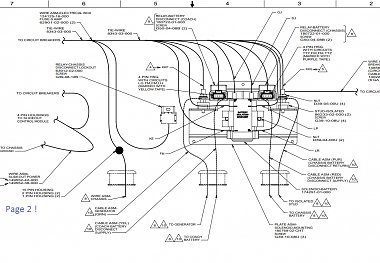
Page 4 without BIM!
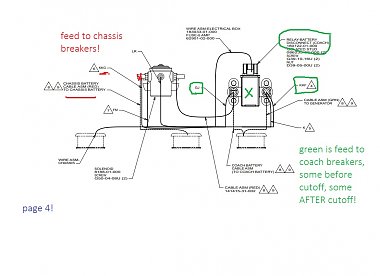
See why I like working on the older, even though it does take work more often?  
But I tried to point out one of the things not often mentioned in the manuals.
I used red to mark the wiring from the chassis to breakers as it comes off the solenoid. I used the solenoid version as easier to read but the same idea is on the BIM version with cutoff for chassis. I used green to point out how there are some breakers fed BEFORE the cutoffs and some AFTER on both coach and chassis battery cutoffs!
It can fool us when we think we have cutoff the batteries but some wiring goes around them! Various safety items are left hot!
To help sort the wiring, they give us labels, both on the wires and on drawings.
Example of small wire ID:
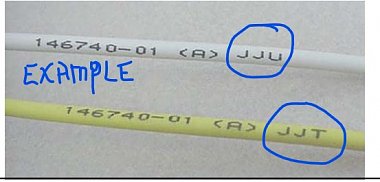
To decode the ID for "from" and "to":
https://www.winnebago.com/Files/File...ical_guide.pdf
You may/may not want or need this info now but at some point, it can really help clear the mind a bit! 
__________________
Richard
Why no RV year, make and floorplan on MY signature as we suggest for others?
I currently DO NOT have one! 
|

|

|
 12-27-2023, 10:47 AM
12-27-2023, 10:47 AM
|
#15
|
|
Winnebago Camper
Join Date: Dec 2023
Posts: 9
|
Quote:
Originally Posted by Wayne M

As Randy pointed out with the BIM, the house batteries are charged first, then it switches to the chassis battery.
The chassis battery has parasitic draws. One of the biggest parasitic draws are the steps. They are controlled by a current limiting switch which means that in order to stay in or out there is a constant current applied. (At least this is what Winnebago told me.)
In my 2008 Winne I was dropping chassis voltage to 11.4 in a matter of days. I called WB and they said to turn the step switch off when in storage. They said that the Trik-L-Charge could not keep up with the current drain.
Once I turned the step switch off I never had another problem of battery drain.
Happy trals!
Merry Christmas everyone!
|
That's interesting, I'll keep that in mind. I do set the switch off most of the time anyhow. But that doesn't apply in my case. With being hooked into shore power, I should be getting power to the battery, but there is none. There is zero volts at the positive cable when I disconnect from the battery. So, the parasites are draining the battery but shore power should keep the battery charged.
|

|

|
 12-27-2023, 11:02 AM
12-27-2023, 11:02 AM
|
#16
|
|
Winnebago Camper
Join Date: Dec 2023
Posts: 9
|
Quote:
Originally Posted by powercat_ras

The 2013 27N drawing shows the BIM module mounted on a integrated Battery Isolation Solenoid and it monitors the coach and chassis battery voltages and provides bi-directional charging logic.
If it sees battery charging voltage on the coach side, and sees a chassis battery voltage that indicates charging is needed it will operate the contactor to allow the coach charging power to also flow to the chassis battery. It will cycle. The contactor makes a loud clunk you will hear in the front part of the RV when it opens or closes, in a 27N it is on the driver's side behind the chassis electrical box which is behind a access door on the driver's side.
|
I located the BIM, just before we left town for Christmas. Back now and I've got a few days to work on this issue before we head south for winter. The BIM is where you said, but behind the fuse panel. I used my endoscope to find it. It does the clunk when I press the battery switch. I looked up the manual and one of the first lines was "it is very hard to troubleshoot" 😒
So how can I determine if it is the BIM is the source of my lack of charge to the start battery?
|

|

|
 01-05-2024, 10:06 PM
01-05-2024, 10:06 PM
|
#17
|
|
Winnebago Master
Join Date: Aug 2008
Location: Texas
Posts: 1,678
|
Quote:
Originally Posted by Islandguy

That's interesting, I'll keep that in mind. I do set the switch off most of the time anyhow. But that doesn't apply in my case. With being hooked into shore power, I should be getting power to the battery, but there is none. There is zero volts at the positive cable when I disconnect from the battery. So, the parasites are draining the battery but shore power should keep the battery charged.
|
Being hooked into shore power your converter is still the culprit that is charging the batteries, it is just that the shore power is feeding the converter which is the charging station. It most likely has a trickle charger in the circuit and the amount of parasitic draw is to much for the trickle charger - just a hunch.
Thinking out loud here, but if there is no power to the battery when plugged into shore power could it be a bad converter, or a defective transfer switch. I have had to replace both over the past several years.
Does your RV has an energy management system (EMS) that displays power and battery conditions?
__________________
Wayne MSGT USMC (Ret) & Earlene (CinCHouse)
2015 Winnebago Tour 42QD - 2020 Lincoln Nautilus Reserve (TOAD)
(RVM-14) It is what it is, and then it is what you make of it.
|

|

|
 01-06-2024, 10:45 AM
01-06-2024, 10:45 AM
|
#18
|
|
Winnebago Camper
Join Date: Dec 2023
Posts: 9
|
Quote:
Originally Posted by Wayne M

Being hooked into shore power your converter is still the culprit that is charging the batteries, it is just that the shore power is feeding the converter which is the charging station. It most likely has a trickle charger in the circuit and the amount of parasitic draw is to much for the trickle charger - just a hunch.
Thinking out loud here, but if there is no power to the battery when plugged into shore power could it be a bad converter, or a defective transfer switch. I have had to replace both over the past several years.
Does your RV has an energy management system (EMS) that displays power and battery conditions?
|
I followed the Progressive Dynamics troubleshooting instructions and I got power leaving the converter on the line going to the battery. Their next instruction was to check the inline fuses and I couldn't find one for the chassis battery. That's when I started this thread. So it seems like the problem is between the converter and the battery, maybe the BIM.
I have an update. We were delayed on leaving on our trip due to a dead battery. My battery monitor said 12.4, but it wouldn't even try to start. Neither did the coach batteries using the switch work. New battery and now we're down in Oregon on our way south. Last night, we were plugged into a 20amp outlet and the battery monitor showed both batteries getting over 13 volts. So now, with a new battery, I don't know why, but it seems to be working properly now. I'm guessing it's something to do with the BIM.
|

|

|
 01-06-2024, 03:52 PM
01-06-2024, 03:52 PM
|
#19
|
|
Site Team
Join Date: Mar 2019
Location: South Bend, WA
Posts: 2,766
|
Quote:
Originally Posted by Islandguy

... New battery and now we're down in Oregon on our way south. Last night, we were plugged into a 20amp outlet and the battery monitor showed both batteries getting over 13 volts. So now, with a new battery, I don't know why, but it seems to be working properly now. I'm guessing it's something to do with the BIM.
|
Could all this be caused by a bad cable connection? Perhaps cleaning the terminals corrected the problem. Did you get the old batteries tested?
Eagle5
__________________
2019 Minnie Winnie 22M on an E-450 frame
|

|

|
 01-07-2024, 09:08 AM
01-07-2024, 09:08 AM
|
#20
|
|
Winnebago Camper
Join Date: Dec 2023
Posts: 9
|
Quote:
Originally Posted by Eagle5

Could all this be caused by a bad cable connection? Perhaps cleaning the terminals corrected the problem. Did you get the old batteries tested?
Eagle5
|
I didn't do anything to the cables. I use those felt pads on the posts and they keep everything clean. I tested the battery with my battery tester and it showed it was just into the green OK range. It started the RV only days before without trouble. I also put a 4 stage charger on it which brought it up to full charge, but still wouldn't start. Bad cell maybe? The battery was only 2.5 years old. It replaced the original Motorcraft battery that was still working after 8 years.
I'm now down on the Oregon coast and when I got up, both coach and chassis batteries were over 13 volts. All I did was get a new battery.
|

|

|
 |
|
|
Currently Active Users Viewing This Thread: 1 (0 members and 1 guests)
|
|
|
 Posting Rules
Posting Rules
|
You may not post new threads
You may not post replies
You may not post attachments
You may not edit your posts
HTML code is Off
|
|
|
|
 » Recent Discussions
» Recent Discussions |
|
|
|
|
|
|
|
|
|
|
|
|
|
|
|
|
|
|
|
|
|
|
|
|
|